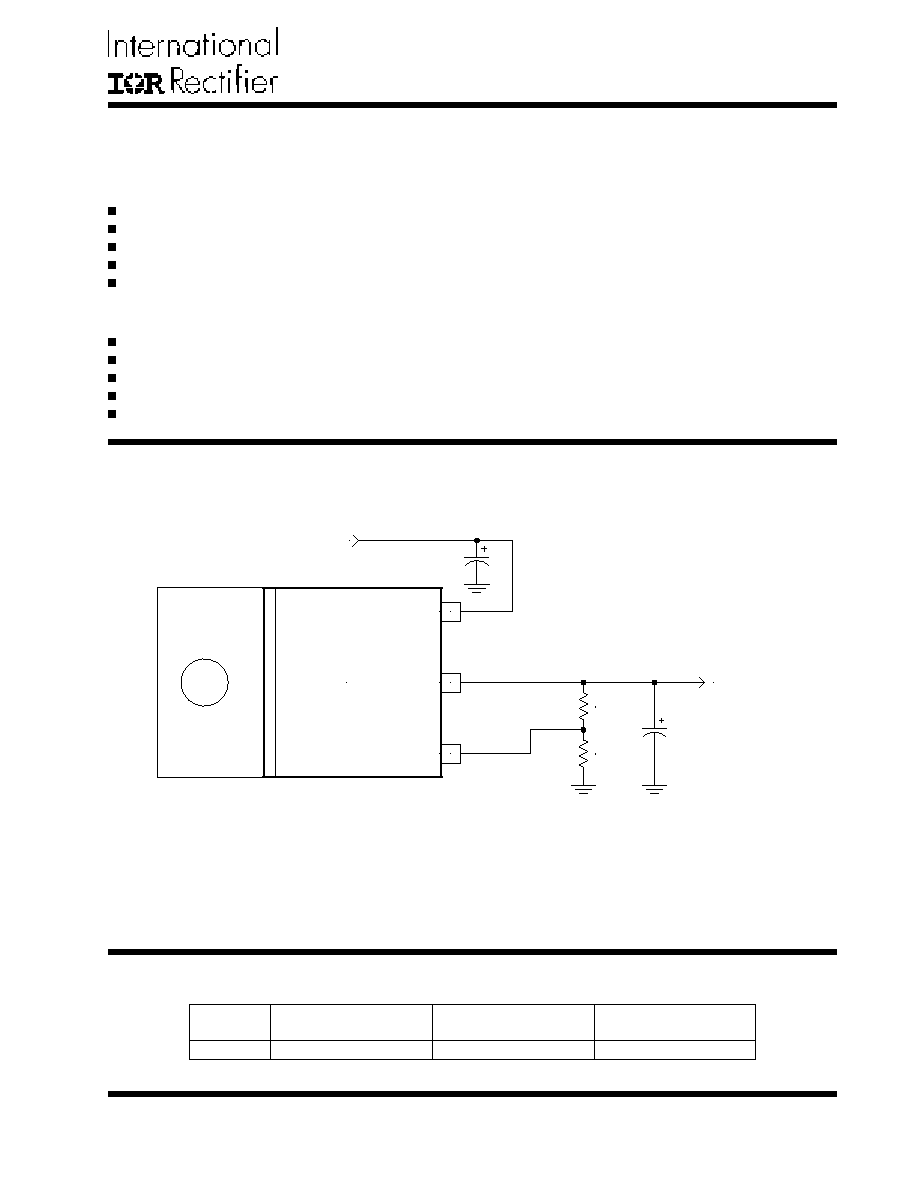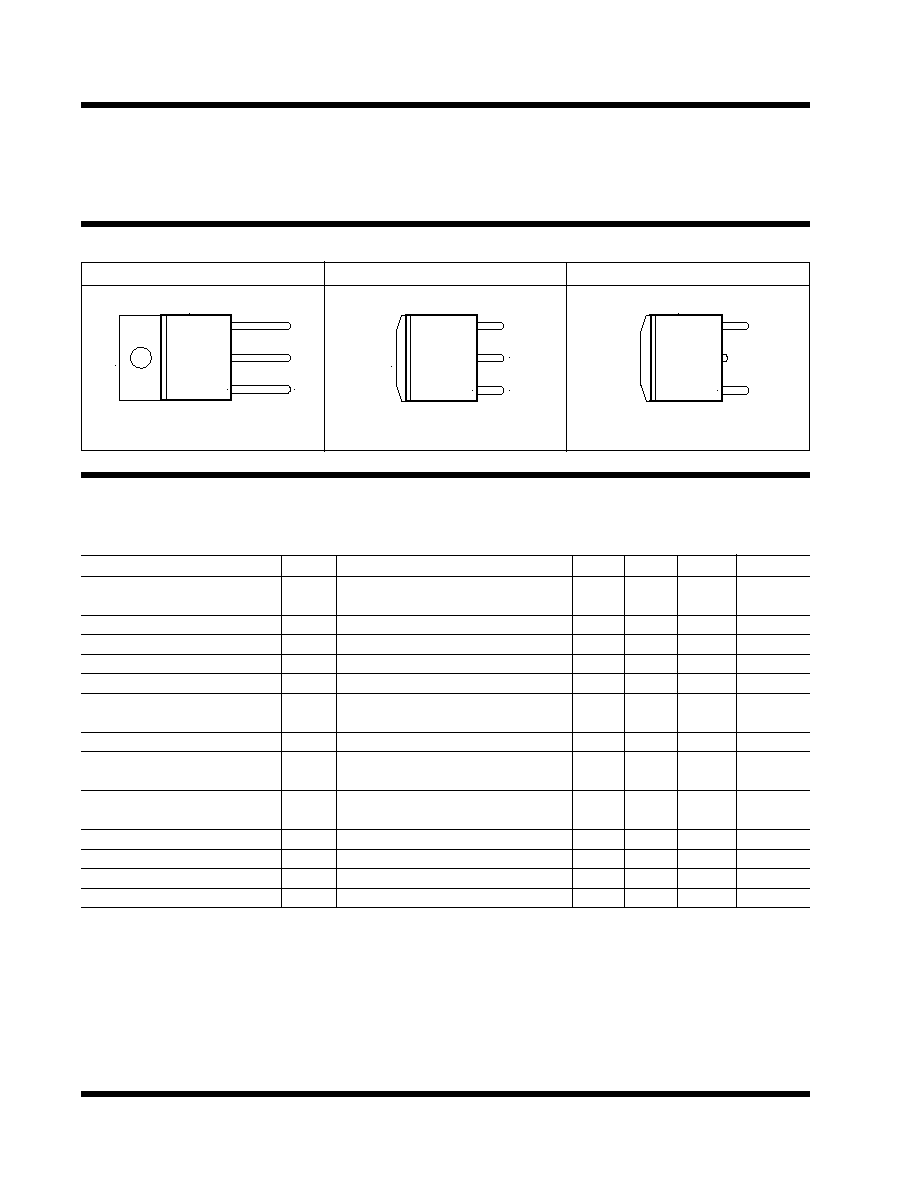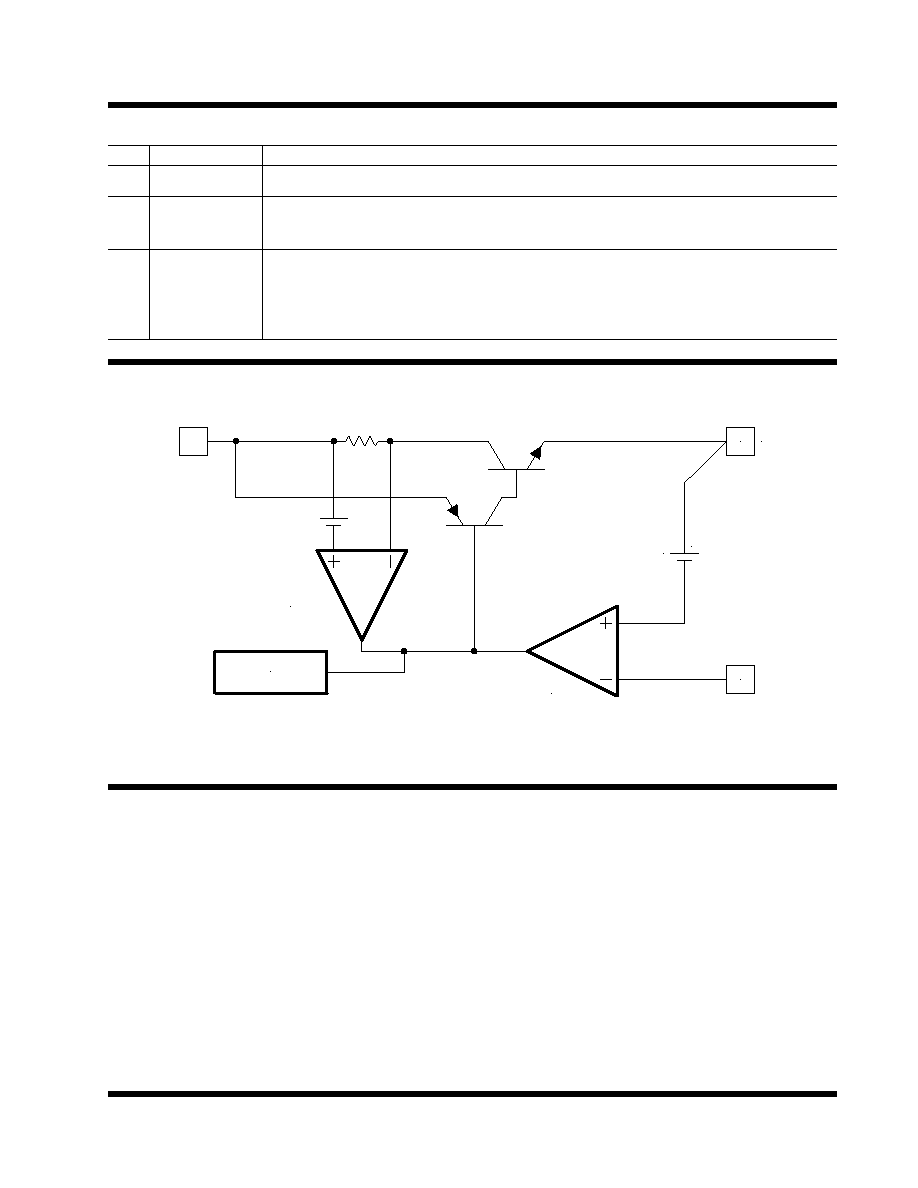Äîêóìåíòàöèÿ è îïèñàíèÿ www.docs.chipfind.ru

IRU1015
1
Rev. 1.1
06/29/01
TYPICAL APPLICATION
DESCRIPTION
The IRU1015 is a low dropout three-terminal adjustable
regulator with minimum of 1.5A output current capabil-
ity. This product is specifically designed to provide well
regulated supply for low voltage IC applications such as
486DX4 processor, P55C
I/O supply as well as high
speed bus termination and low current 3.3V logic sup-
ply. The IRU1015 is also well suited for other applica-
tions such as VGA and sound card. The IRU1015 is
guaranteed to have <1.3V dropout at full load current
making it ideal to provide well regulated outputs of 2.5V
to 3.3V with 4.75V to 7V input supply.
1.5A LOW DROPOUT POSITIVE
ADJUSTABLE REGULATOR
Figure 1 - Typical application of IRU1015 in a 5V to 3.3V regulator
Tj (°C)
3-PIN PLASTIC
3-PIN PLASTIC
2-PIN PLASTIC
TO-220 (T)
TO-263 (M)
TO-252 (D-Pak)
0 To 150 IRU1015CT
IRU1015CM
IRU1015CD
Data Sheet No. PD94122
C2
1500uF
5V
3.3V / 1.5A
R1
121
R2
200
C1
1500uF
IRU1015
1015app1-1.1
1
2
3
Adj
Vin
Vout
PACKAGE ORDER INFORMATION
Note: P55C is trademark of Intel Corp.
Guaranteed < 1.3V Dropout at Full Load Current
Fast Transient Response
1% Voltage Reference Initial Accuracy
Output Current Limiting
Built-In Thermal Shutdown
FEATURES
APPLICATIONS
486DX4 Supply Voltage
P55 I/O Supply Voltage
VGA & Sound Card Applications
Low Voltage High Speed Termination Applications
Standard 3.3V Chip Set and Logic Applications

IRU1015
2
Rev. 1.1
06/29/01
ABSOLUTE MAXIMUM RATINGS
Input Voltage (Vin) .................................................... 7V
Power Dissipation ..................................................... Internally Limited
Storage Temperature Range ...................................... -65°C To 150°C
Operating Junction Temperature Range ..................... 0°C To 150°C
PACKAGE INFORMATION
3-PIN PLASTIC TO-220 (T)
3-PIN PLASTIC TO-263 (M) 2-PIN PLASTIC TO-252 (D-Pak)
JT
=2.7
°
C/W
JA
=60
°
C/W
JA
=35
°
C/W for 1" Square pad
JA
=70
°
C/W for 0.5" Square pad
PARAMETER
SYM
TEST CONDITION
MIN
TYP
MAX
UNITS
Reference Voltage Vref
Io=10mA, Tj=25!C, (Vin-Vo)=1.5V 1.238 1.250
1.262 V
Io=10mA, (Vin-Vo)=1.5V 1.225 1.250
1.275
Line Regulation
Io=10mA, 1.3V<(Vin-Vo)<7V
0.2
%
Load Regulation (Note 1)
Vin=3.3V, Vadj=0, 10mA<Io<1.5A
0.4
%
Dropout Voltage (Note 2)
Vo
Note 2, Io=1.5A
1.1
1.3
V
Current Limit
Vin=3.3V, dVo=100mV
1.6
A
Minimum Load Current
Vin=3.3V, Vadj=0V
5
10
mA
(Note 3)
Thermal Regulation
30ms Pulse, Vin-Vo=3V, Io=1.5A
0.01
0.02
%/W
Ripple Rejection
f=120Hz, Co=25µF Tantalum,
Io=0.75A, Vin-Vo=3V
60 70
dB
Adjust Pin Current
Iadj
Io=10mA, Vin-Vo=1.5V, Tj=25!C,
Io=10mA, Vin-Vo=1.5V
55
120
µA
Adjust Pin Current Change
Io=10mA, Vin-Vo=1.5V, Tj=25!C
0.2
5
µA
Temperature Stability
Vin=3.3V, Vadj=0V, Io=10mA
0.5
%
Long Term Stability
Tj=125!C, 1000Hrs
0.3
1
%
RMS Output Noise
Tj=25!C, 10Hz<f<10KHz
0.003
%Vo
Adj
Tab is
Vout
Vin
Vout
1
2
3
FRONT VIEW
Adj
Tab is
Vout
Vin
1
3
FRONT VIEW
Vout
Adj
Tab is
Vout
Vin
1
3
FRONT VIEW
ELECTRICAL SPECIFICATIONS
Unless otherwise specified, these specifications apply over Cin=1µF, Cout=10µF, and Tj=0 to 150!C.
Typical values refer to Tj=25!C.
Note 1: Low duty cycle pulse testing with Kelvin con-
nections is required in order to maintain accurate data.
Note 2: Dropout voltage is defined as the minimum dif-
ferential voltage between Vin and Vout required to main-
tain regulation at Vout. It is measured when the output
voltage drops 1% below its nominal value.
Note 3: Minimum load current is defined as the mini-
mum current required at the output in order for the out-
put voltage to maintain regulation. Typically the resistor
dividers are selected such that it automatically main-
tains this current.

IRU1015
3
Rev. 1.1
06/29/01
APPLICATION INFORMATION
Introduction
The IRU1015 adjustable Low Dropout (LDO) regulator is
a three-terminal device which can easily be programmed
with the addition of two external resistors to any volt-
ages within the range of 1.25 to 5.5 V.This regulator un-
like the first generation of the three-terminal regulators
such as LM117 that required 3V differential between the
input and the regulated output, only needs 1.3V differen-
tial to maintain output regulation. This is a key require-
ment for today's microprocessors that need typically
3.3V supply and are often generated from the 5V sup-
ply. Another major requirement of these microproces-
sors is the need to switch the load current from zero to
full load in tens of nanoseconds at their pins, which
translates to an approximately 300 to 500ns current step
at the regulator. In addition, the output voltage toler-
ances are sometimes tight and they include the tran-
sient response as part of the specification.
The IRU1015 is specifically designed to meet the fast
current transient needs as well as provide an accurate
initial voltage, reducing the overall system cost with the
need for fewer output capacitors.
Vin 3
1015blk1-1.0
1 Adj
2 Vout
THERMAL
SHUTDOWN
CURRENT
LIMIT
1.25V
+
+
Figure 2 - Simplified block diagram of the IRU1015
BLOCK DIAGRAM
PIN # PIN SYMBOL
PIN DESCRIPTION
PIN DESCRIPTIONS
A resistor divider from this pin to the Vout pin and ground sets the output voltage.
The output of the regulator. A minimum of 10µF capacitor must be connected from this pin
to ground to insure stability.
The input pin of the regulator. Typically a large storage capacitor is connected from this
pin to ground to insure that the input voltage does not sag below the minimum drop out
voltage during the load transient response. This pin must always be 1.3V higher than Vout
in order for the device to regulate properly.
1
2
3
Adj
Vout
Vin

IRU1015
4
Rev. 1.1
06/29/01
Output Voltage Setting
The IRU1015 can be programmed to any voltages in the
range of 1.25V to 5.5V with the addition of R1 and R2
external resistors according to the following formula:
Figure 3 - Typical application of the IRU1015
for programming the output voltage.
The IRU1015 keeps a constant 1.25V between the out-
put pin and the adjust pin. By placing a resistor R1 across
these two pins a constant current flows through R1, add-
ing to the Iadj current and into the R2 resistor producing
a voltage equal to the (1.25/R1)*R2 + Iadj*R2 which will
be added to the 1.25V to set the output voltage. This is
summarized in the above equation. Since the minimum
load current requirement of the IRU1015 is 10mA, R1 is
typically selected to be 121 resistor so that it auto-
matically satisfies the minimum current requirement.
Notice that since Iadj is typically in the range of 50µA it
only adds a small error to the output voltage and should
only be considered when a very precise output voltage
setting is required. For example, in a typical 3.3V appli-
cation where R1=121 and R2=200 the error due to
Iadj is only 0.3% of the nominal set point.
Load Regulation
Since the IRU1015 is only a three-terminal device, it is
not possible to provide true remote sensing of the output
voltage at the load. Figure 4 shows that the best load
regulation is achieved when the bottom side of R2 is
connected to the load and the top side of R1 resistor is
connected directly to the case or the Vout pin of the
Figure 4 - Schematic showing connection
for best load regulation
regulator and not to the load. In fact, if R1 is connected
to the load side, the effective resistance between the
regulator and the load is gained up by the factor of (1+R2/
R1), or the effective resistance will be, Rp(eff)=Rp*(1+R2/
R1). It is important to note that for high current applica-
tions, this can represent a significant percentage of the
overall load regulation and one must keep the path from
the regulator to the load as short as possible to mini-
mize this effect.
Vout
1015app2-1.0
R1
R2
Vin
Vref
IAdj = 50uA
IRU1015
Adj
Vout
Vin
1015app3-1.0
R1
R2
Vin
RL
Rp
PARASITIC LINE
RESISTANCE
IRU1015
Adj
Vout
Vin
Stability
The IRU1015 requires the use of an output capacitor as
part of the frequency compensation in order to make the
regulator stable. Typical designs for microprocessor ap-
plications use standard electrolytic capacitors with a
typical ESR in the range of 50 to 100m and an output
capacitance of 500 to 1000µF. Fortunately as the ca-
pacitance increases, the ESR decreases resulting in a
fixed RC time constant. The IRU1015 takes advantage
of this phenomena in making the overall regulator loop
stable. For most applications a minimum of 100µF alu-
minum electrolytic capacitor such as Sanyo MVGX se-
ries, Panasonic FA series as well as the Nichicon PL
series insures both stability and good transient response.
Thermal Design
The IRU1015 incorporates an internal thermal shutdown
that protects the device when the junction temperature
exceeds the maximum allowable junction temperature.
Although this device can operate with junction tempera-
tures in the range of 150!C, it is recommended that the
selected heat sink be chosen such that during maxi-
mum continuous load operation the junction tempera-
ture is kept below this number. The example below
Where:
V
REF
= 1.25V Typically
I
ADJ
= 50µA Typically
R
1
and R
2
as shown in figure 3:
V
OUT
= V
REF
× o
o
o
o
o1 + p
p
p
p
p + I
ADJ
× R
2
R
2
R
1

IRU1015
5
Rev. 1.1
06/29/01
shows the steps in selecting the proper regulator heat
sink for an AMD 486DX4-120 MHz processor.
Assuming the following specifications:
The steps for selecting a proper heat sink to keep the
junction temperature below 135
°
C is given as:
1) Calculate the maximum power dissipation using:
2) Select a package from the regulator data sheet and
record its junction to case (or Tab) thermal resistance.
Selecting TO-220 package gives us:
3) Assuming that the heat sink is black anodized, cal-
culate the maximum Heat sink temperature allowed:
Assume,
cs=0.05
°
C/W (heat-sink-to-case thermal
resistance for black anodized)
4) With the maximum heat sink temperature calculated
in the previous step, the heat-sink-to-air thermal re-
sistance (
SA
) is calculated by first calculating the
temperature rise above the ambient as follows:
5) Next, a heat sink with lower
sa than the one calcu-
lated in step 4 must be selected. One way to do this
is to simply look at the graphs of the "Heat Sink Temp
Rise Above the Ambient" vs. the "Power Dissipation"
and select a heat sink that results in lower tempera-
ture rise than the one calculated in the previous step.
The following heat sinks from AAVID and Thermalloy
meet this criteria.
Note: For further information regarding the above com-
panies and their latest product offerings and application
support contact your local representative or the num-
bers listed below:
AAVID...............PH# (603) 528 3400
Thermalloy.........PH# (214) 243-4321
Designing for Microprocessor Applications
As it was mentioned before the IRU1015 is designed
specifically to provide power for the new generation of
the low voltage processors requiring voltages in the range
of 2.5V to 3.6V generated by stepping down the 5V
supply. These processors demand a fast regulator that
supports their large load current changes. The worst case
current step seen by the regulator is anywhere in the
range of 1 to 7A with the slew rate of 300 to 500ns which
could happen when the processor transitions from "Stop
Clock" mode to the "Full Active" mode. The load current
step at the processor is actually much faster, in the or-
der of 15 to 20ns, however, the de-coupling capacitors
placed in the cavity of the processor socket handle this
transition until the regulator responds to the load current
levels. Because of this requirement the selection of high
frequency low ESR and low ESL output capacitor is
imperative in the design of these regulator circuits.
Figure 5 shows the effects of a fast transient on the
output voltage of the regulator. As shown in this figure,
the ESR of the output capacitor produces an instanta-
neous drop equal to the (
VESR=ESR*
I) and the ESL
effect will be equal to the rate of change of the output
current times the inductance of the capacitor (
VESL
=L*
I/
t). The output capacitance effect is a droop in
the output voltage proportional to the time it takes for
the regulator to respond to the change in the current,
(
VC =
t *
I / C ) where
t is the response time of the
regulator.
Air Flow (LFM)
0 100
Thermalloy 6041PB No HS Required
AAVID 574602 No HS Required
T
S
= T
J
- P
D
× (
JC
+
CS
)
T
S
= 135 - 1.86 × (2.7 + 0.05) = 129!C
P
D
= I
OUT
× (V
IN
- V
OUT
)
P
D
= 1.2 × (5 - 3.45) = 1.86W
V
IN
= 5V
V
OUT
= 3.45V
I
OUT(MAX)
= 1.2A
T
A
= 35!C
JC
= 2.7!C/W
SA
= = = 50!C/W
94
1.86
T
P
D
T = T
S
- T
A
= 129 - 35 = 94!C
T = Temperature Rise Above Ambient




